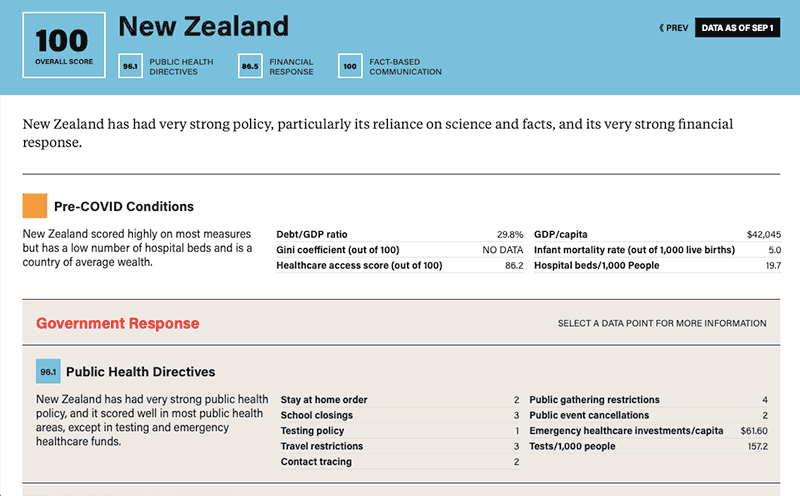Travel and tourism will be changed forever. We asked seven leading thinkers for their predictions.
- 82.3 Public Health
Directives - 51.4 Financial
Response - 100 Fact-Based
Communication
Senegal’s COVID-19 policy response has been very strong across the board, buoyed by strong public health directives and a reliance on science and facts.
Pre-COVID Conditions
Senegal is among the most poorly performing countries on infant mortality, hospital beds, wealth, and healthcare.
- Debt/GDP ratio 61.6%
- GDP/capita $4,079
- Gini coefficient (out of 100) 40.3
- Infant mortality rate (out of 1,000 live births) 32
- Healthcare access score (out of 100) 44.4
- Hospital beds/1,000 People 1.5
Government Response
Select a data point for more information(Data points represent policy level as of Jan 1.)
Public Health Directives
Senegal has had relatively strong public health policy, implementing an early and strict stay-at-home order and strongly restricting public gatherings; limited testing and minimal emergency healthcare spending bring its score down.
- Stay at home order 0
- Public gathering restrictions 2
- School closings 0
- Public event cancellations 2
- Testing policy 0
- Emergency healthcare investments/capita $6.34
- Travel restrictions 3
- Tests/1,000 people 16.7
- Contact tracing 2
Financial Response
Senegal had a median financial response to the pandemic, particularly its very generous debt-forbearance policy, which counterbalances relatively weak income support and a small stimulus.
- Financial stimulus as share of GDP 5.7%
- Income support 0
- Debt forebearance 0
Fact-Based Communication
Senegal’s government is very strong in this category, as it has not engaged in misinformation or limited press freedom in response to COVID-19.
- Reliance on science/fact based information 0
- Press freedom 0
COVID-19 Status as of Jan 1
Senegal is relatively strong in this category, with low numbers of cases and deaths, likely heavily aided by its very high public health policy score.
- Total deaths 410
- Death rate per 100K 24.5
- Total cases 19,364
- Cases per 100K 1,157
- Percent of positive tests 10.6
- Change in positivity rates +8.3
| Date | Status | New Cases/1M | |
|---|---|---|---|
| 1 | May 11 | Mosques, churches, and businesses are allowed to reopen | 5.25 |
| 2 | Jun 30 | Curfew ends | 6.48 |
Differentiating Factors
- Curfew in Dakar leads to protests: Senegalese President Macky Sall imposed a 9:00 pm curfew on Dakar and the surrounding region, where 90 percent of COVID-19 infections are concentrated. In response, protests erupted, particularly among young people who rely on informal and piecemeal work. Read More
- Second wave hits Africa as temperatures cool: West and Central African nations are recording near-record levels of infection, as the weather cools and governments struggle to enforce restrictions after many months and a harsh economic toll. Read More
- African nations work together to procure vaccines: As vaccine rollouts begin globally, African leaders are working together to access doses and reach vaccine readiness, including by raising money to pay pharmaceutical companies and reducing reliance on the WHO's vaccine distribution plan, which is unlikely to mobilize until mid-2021. Read More
- Universities open: Universities opened and students will attend classes in-person or on rotation as cases remain low. Read More
- Education through television: Senegal continues to take a creative approach to COVID-19, releasing plans for remote learning by broadcasting lessons and lectures on TV while its schools remain closed. Read More
- Guaranteed beds for COVID-19 patients: Senegal's strategy has centered around an early pledge made by the government that every diagnosed coronavirus patient would receive a hospital bed. Read More
- Ebola experience key to COVID-19 success: Preparation has been key to Senegal's early success in keeping cases low. Since the Ebola outbreak five years ago, the government has run several simulations providing training to respond to virus outbreaks, and health officials created a COVID-19 response plan in early January, over a month before the country's first case was reported. Read More
Compared with Other African Countries
-
96.4Ethiopia 124,652
Cases 1,084
Per 1M 1,937
DeathsDespite having relatively weak pre-pandemic capacity, swift action and prevention-based messaging from the government helped mitigate spread early on in the crisis.
-
98.1Ghana 54,930
Cases 1,768
Per 1M 335
DeathsGhana scores strongly on the Index, due primarily to its proactive public health policy, strong examples set by leadership, and reliance on facts; while consistently strong, it does have very weak testing, limited emergency healthcare spending, and a weak stimulus.
-
100Kenya 96,614
Cases 1,797
Per 1M 1,681
DeathsKenya has a strong overall policy score, although down significantly from January. However, it is consistently scoring well in all areas, particularly its reliance with respect to facts and science on COVID-19.
-
54.9South Africa 1,073,887
Cases 18,107
Per 1M 28,887
DeathsOverall, South Africa's score is relatively strong with vigorous policy implementation—particularly with respect to lockdowns—offset by its relatively meager financial response.
Further Reading From Foreign Policy
Be the source of actionable insight.
Select one of the subscription options below to read the full Covid-19 Global Response Index. Unlock even more global intelligence with a subscription to FP Insider.
Already an FP Insider? Log In
Looking for group access? Contact us directly

Statistics and government response factors available on each country profile include:
Pre-COVID Conditions:
- Debt to GDP ratio
- Infant mortality rates
- Hospital beds per 1,000 people
- Gini coefficients measuring inequality
- Health access and quality
COVID-19 Public Health Directives:
- Stay-at home orders
- School-closing policy
- Public-gathering restrictions
- Cancellation of public events
- Testing policy and rates per 1,000 people
- Emergency healthcare spending per capita
- Travel restrictions
- Contact tracing
COVID-19 Financial Response:
- Stimulus package as a share of GDP
- Income support
- Debt-forbearance
Public Communications:
- Instances of misinformation by leadership
- Limitations on press freedom, censorship
Current/Historic In-Country COVID-19 Status:
- Death rates per 1 million
- Case rates per 1 million


